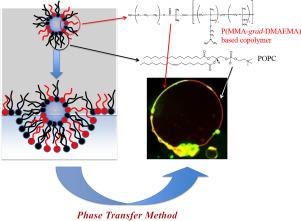Biochimica et Biophysica Acta (BBA) - General Subjects ( IF 2.8 ) Pub Date : 2020-04-07 , DOI: 10.1016/j.bbagen.2020.129611 Ylenia Miele 1 , Anne-Françoise Mingotaud 2 , Enrico Caruso 3 , Miryam C Malacarne 3 , Lorella Izzo 3 , Barbara Lonetti 2 , Federico Rossi 4

|
Background
In recent years, there has been a growing interest in the formation of copolymer-lipid hybrid self-assemblies, which allow combining and improving the main features of pure lipid-based and copolymer-based systems known for their potential applications in the biomedical field. As the most common method used to obtain giant vesicles is electroformation, most systems so far used low Tg polymers for their flexibility at room temperature.
Methods
Copolymers used in the hybrid vesicles have been synthesized by a modified version of the ATRP, namely the Activators ReGenerated by Electron Transfer ATRP and characterized by NMR and DSC. Giant hybrid vesicles have been obtained using electroformation and droplet transfer method. Confocal fluorescence microscopy was used to image the vesicles.
Results
Electroformation enabled to obtain hybrid vesicles in a narrow range of compositions (15 mol% was the maximum copolymer content). This range could be extended by the use of a droplet transfer method, which enabled obtaining hybrid vesicles incorporating a methacrylate-based polymer in a wide range of compositions. Proof of the hybrid composition was obtained by fluorescence microscopy using labeled lipids and copolymers.
Conclusions
This work describes for the first time, to the best of our knowledge, the formation of giant hybrid polymer/lipid vesicles formed with such a content of a polymethylmethacrylate copolymer, the glass temperature of which is above room temperature.
General significance
This work shows that polymer structures, more complex than the ones mostly employed, can be possibly included in giant hybrid vesicles by using the droplet transfer method. This will give easier access to functionalized and stimuli-responsive giant vesicles and to systems exhibiting a tunable permeability, these systems being relevant for biological and technological applications.
中文翻译:

混合的巨型脂质囊泡与PMMA基共聚物
背景
近年来,人们对共聚物-脂质杂化自组装体的形成越来越感兴趣,该组合体可以结合和改进以脂质为基础的纯脂质和基于共聚物的系统的主要特征,这些系统因其在生物医学领域的潜在应用而闻名。由于用于获得巨大囊泡的最常用方法是电铸,因此迄今为止,大多数系统都使用低T g聚合物,以使其在室温下具有柔韧性。
方法
杂交囊泡中使用的共聚物已通过ATRP的改进版合成,即通过电子转移ATRP再生并通过NMR和DSC表征的活化剂。使用电形成和液滴转移方法已经获得了巨大的杂种囊泡。共聚焦荧光显微镜用于使囊泡成像。
结果
电形成使得能够在窄范围的组成中获得杂化囊泡(15mol%是最大共聚物含量)。该范围可以通过使用液滴转移方法来扩展,该液滴转移方法能够获得在各种组成中掺入基于甲基丙烯酸酯的聚合物的杂化囊泡。使用标记的脂质和共聚物通过荧光显微镜获得了杂化组合物的证明。
结论
就我们所知,这项工作首次描述了由玻璃化温度高于室温的这种含量的聚甲基丙烯酸甲酯共聚物形成的巨型杂化聚合物/脂质囊泡的形成。
一般意义
这项工作表明,通过使用液滴转移方法,比大多数采用的聚合物结构复杂的聚合物结构可能包含在巨型杂种囊泡中。这将使人们更容易接近功能化的,对刺激有反应的巨型囊泡以及具有可调渗透性的系统,这些系统与生物学和技术应用有关。











































 京公网安备 11010802027423号
京公网安备 11010802027423号